The king of souvenirs in Japan is probably chopsticks. You can buy them everywhere, they’re cheap, don’t take up space in a suitcase, and are actually practical when you miss Japan and want to stuff yourself with sushi after returning home.
But there’s one problem: you’ll quickly realize they don’t remind you of the great times you had in Japan as you thought they would.
That’s because a cheap (or even expensive) trinket bought in two minutes at a souvenir shop rarely holds the sentiment you’re looking for.
No, you need to attach some kind of emotional value to your souvenir.
It could be as simple as a train ticket you kept in your wallet for the entire trip. That ticket was annoying to always carry, but now when you look at it, you’re reminded of the good times. It’s covered in stamps and a bit battered from all your adventures, but that’s what gives it value.
Obviously, you don’t want to keep chopsticks in your wallet for the whole duration of your trip.
So what about making them yourself?
That’s what I did at Mogami Kogei, a traditional woodworking workshop in the heart of Tokyo. The experience is offered by Wabunka, and let me start by saying I absolutely loved it. I’ve been living in Japan since 2019 and working in the Japan travel industry for just as long. I’ve seen countless similar craft workshops, but this one was by far the most authentic experience I’ve had the chance to take part in.
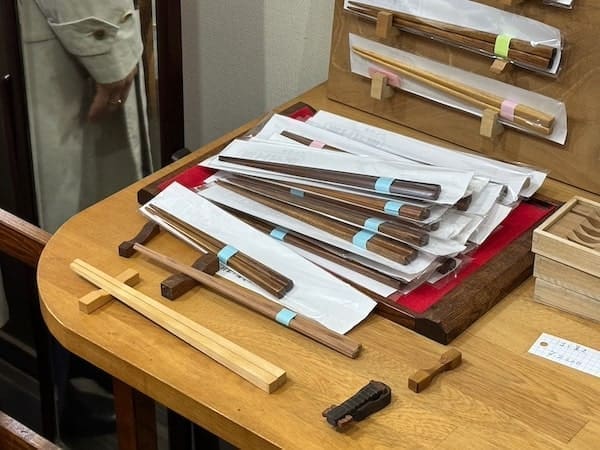
Wabunka curates cultural and traditional experiences. All experiences are private, meaning no mixed groups. They work with renowned Japanese venues, artists, teachers, and artisans. Since most of them don’t speak English, Wabunka assigns a licensed national guide for interpretation.
(Disclaimer: I’ve also worked with Wabunka as a freelance, so I know them personally. I can vouch for their professionalism.)
So when I got the chance to participate in one of their experiences, I jumped at it. Here is my full review.
The Chopstick-Making Experience
You can book this experience online on Wabunka.
I actually made a short video about it, you can watch it here:
Visiting the Master’s Workshop
My group arrived at the location and met our guide, Saori-san. Kind and extremely knowledgeable, I knew I was in for a great time when she greeted us warmly and introduced the workshop and its owner, Mogami-san.
A humble man of small stature and a round face, he showed us around the small entrance of his workshop, which doubles as a storefront and exposition space for some of his creations.
Mogami-san uses a traditional Japanese woodworking technique called Edo Sashimono. As you can imagine with traditional techniques, they’re not doing so well, and Mogami-san is one of the last craftsmen to use it.
Basically, this technique doesn’t use nails to attach pieces of wood together. Instead, it uses a clever system of interlocking wood pieces to create objects. This intricate joinery method results in strong and beautifully crafted items.
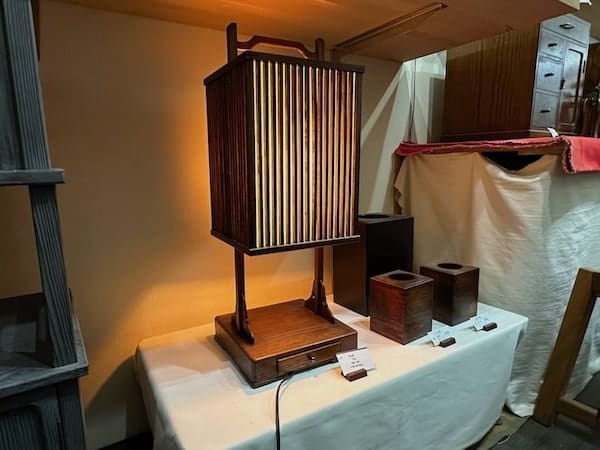
Chopsticks are just a single piece of wood, so they don’t use this technique, but Mogami-san was kind enough to show us some of his more complicated creations and current projects (a makeup and accessory box for a Kabuki actor).
Mogami-san and Saori-san led us upstairs to tour his workshop. It was just as I imagined: it smelled like wood, there were lots of tools I had never even seen, and it was a mess that would make Marie Kondo faint. A true craftsman’s workshop.
Crafting My Chopsticks
Before starting the chopstick-making experience, he offered us traditional outfits, which I happily accepted as I looked ten times cooler than usual in them.
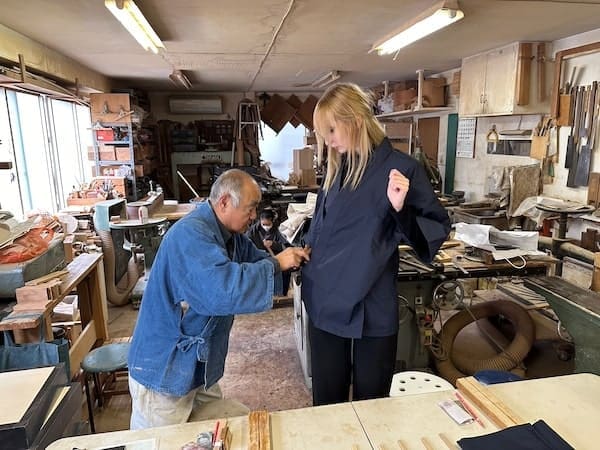
We then sat at the table where Mogami-san had prepared the materials for the experience.
The lesson began with Mogami-san’s clear instructions and the help of our amazing guide, Saori-san, who translated everything.
Honestly, I thought it would be a piece of cake. Oh boy, was I wrong.
I should have seen it coming though—I struggle with IKEA furniture way more than I should.
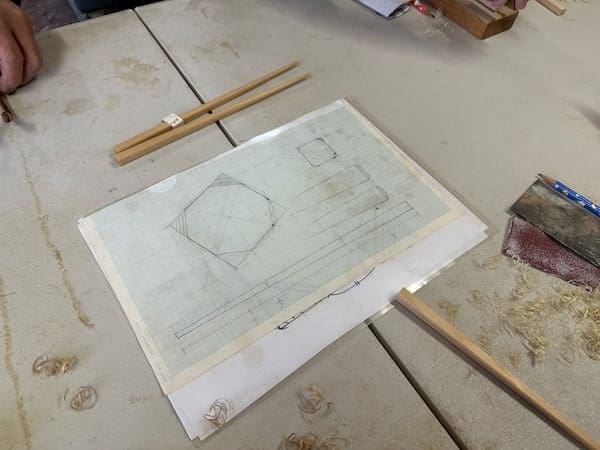
First, we had to choose our wood. We had the choice between cypress, oak, and several other types of wood. I went with oak.
Then Mogami-san showed us how to chip at the corners repeatedly to shape the chopsticks. We started at the top, then the bottom, and repeated the process to make them smaller and rounder.
Next came the sanding to make them completely smooth and to round the top and bottom of the chopsticks. Mogami-san kindly instructed that ‘they should look like Tokyo Dome’ referring to its iconic rounded dome.
And finally, the finishing touch: lackering. This transformed my chopsticks from a piece of raw wood to a masterpiece.
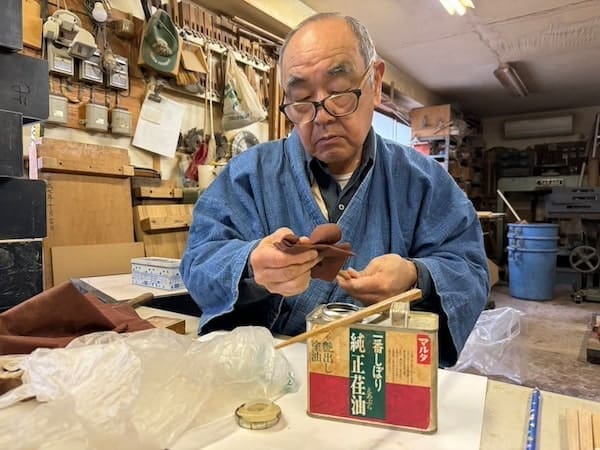
Clumsy as I am, I messed up at every step. Fortunately, Mogami-san was always able to fix all my mistakes. Even though my own skills were responsible for probably around 1% of the work while Mogami-san actually did the other 99%, I ended up with beautiful chopsticks I can be proud of.
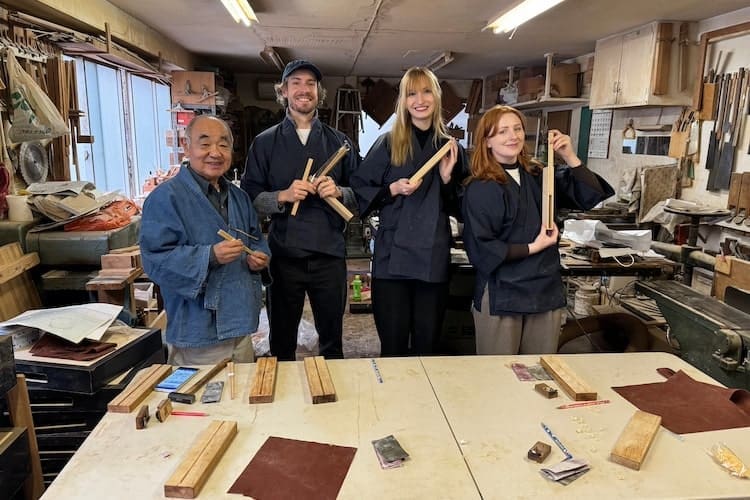
Learning From The Master
And all the while, we got the chance to talk with Mogami-san and hear his stories – about how his grandfather worked in the same workshop, about his son who’s an apprentice in a different workshop in West Japan but who’s going to take over the Mogami Kogei workshop someday, about the state of his industry, and all the questions that came to our mind when we were not too focused on chipping at our chopsticks.
After the experience, we bid farewell and walked back to the closest station with Saori-san. She explained that Mogami-san was at first worried about providing the experience to non-Japanese speakers. He’s shy by nature and was concerned it would be hard to carry the experience with people from a different culture.
But he decided to give it a go, and Saori-san told us he now thoroughly enjoys it.
Who is This Experience For?
Needless to say, I really enjoyed this experience.
Please not that if you’re already good with your hands though, you might find making chopsticks a bit easy. And if you already know how to make your own chopstick, and have the tools to make them back home, you probably won’t learn anything new here.
But I think anybody will enjoy spending time with Mogami-san, no matter what. He’s a master craftsman with 47 years of experience at the time of writing. I’ll let you imagine how much you can learn from him. And even though he’s shy and might not seem like a big talker, don’t hesitate to ask him a lot of questions. He’ll be more than happy to answer.
Here is a video from the Wabunka YouTube channel where you can see him:
One last note: chopstick making experiences are very kid and teenager friendly, so it will be perfect for families looking to do something special while in Tokyo. And if your kids are into manual work, they’ll absolutely love it.
How to Book this Chopstick-Making Experience at Mogami Kogei Workshop?
This experience is offered by Wabunka. They work directly with artisans like Mogami-san, design the experiences, and provide a guide. You can book online on their website.
More Information
You can read my article about the best chopstick-making experience in Japan here.

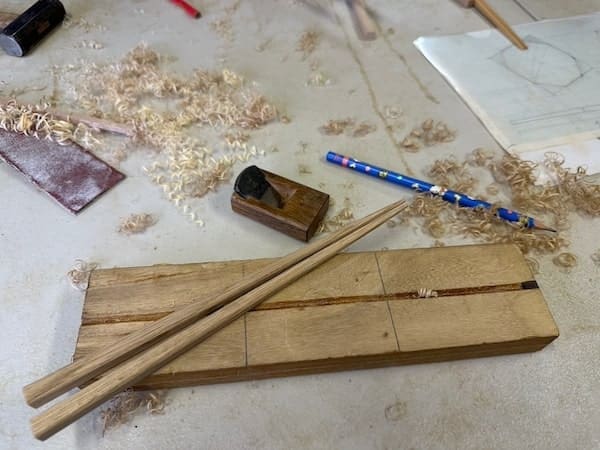
Comments are closed.